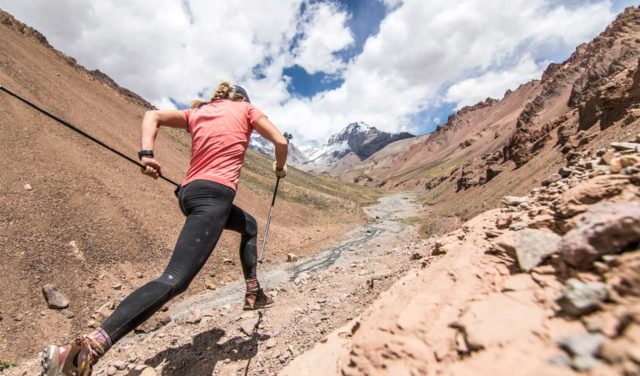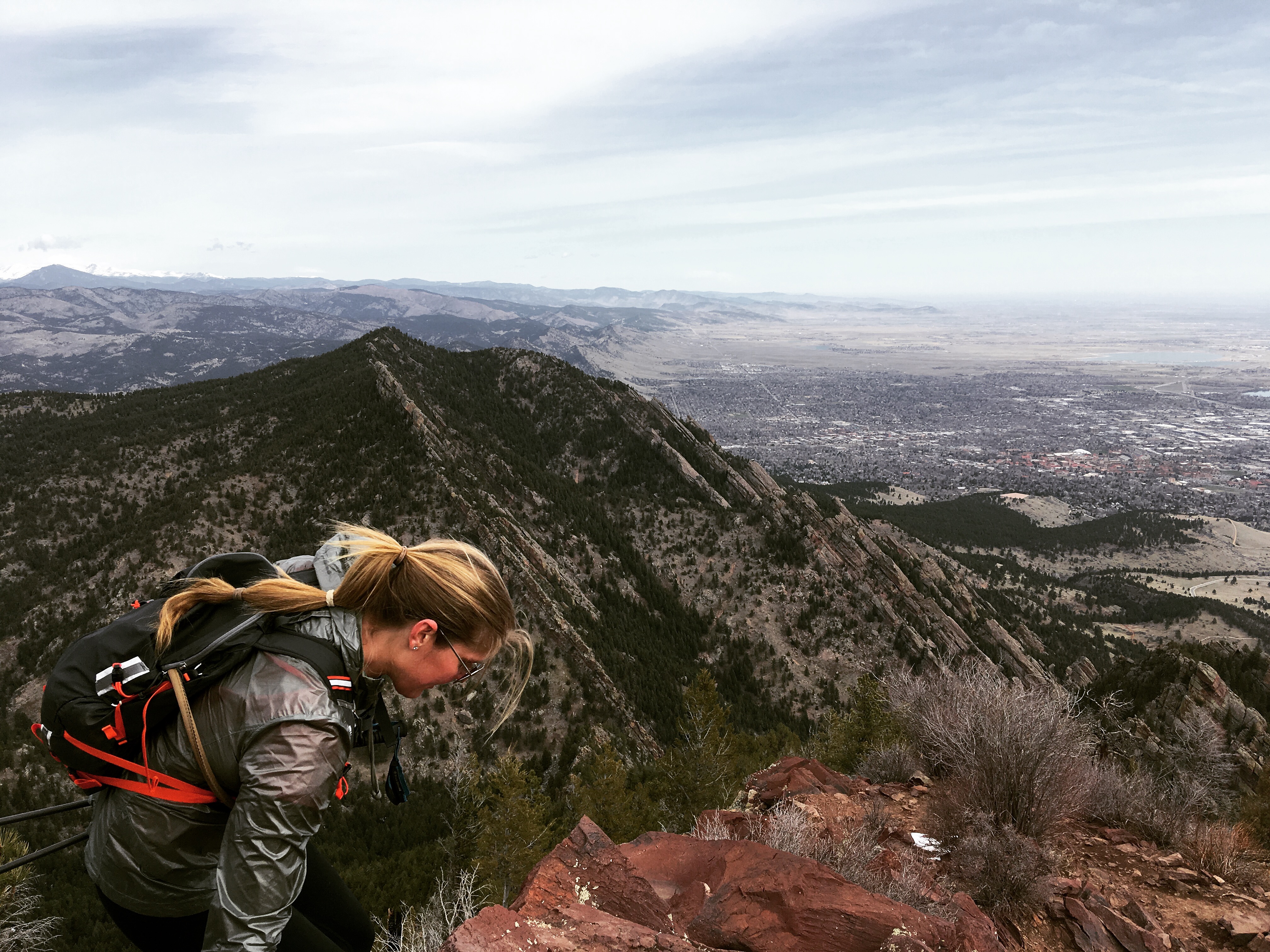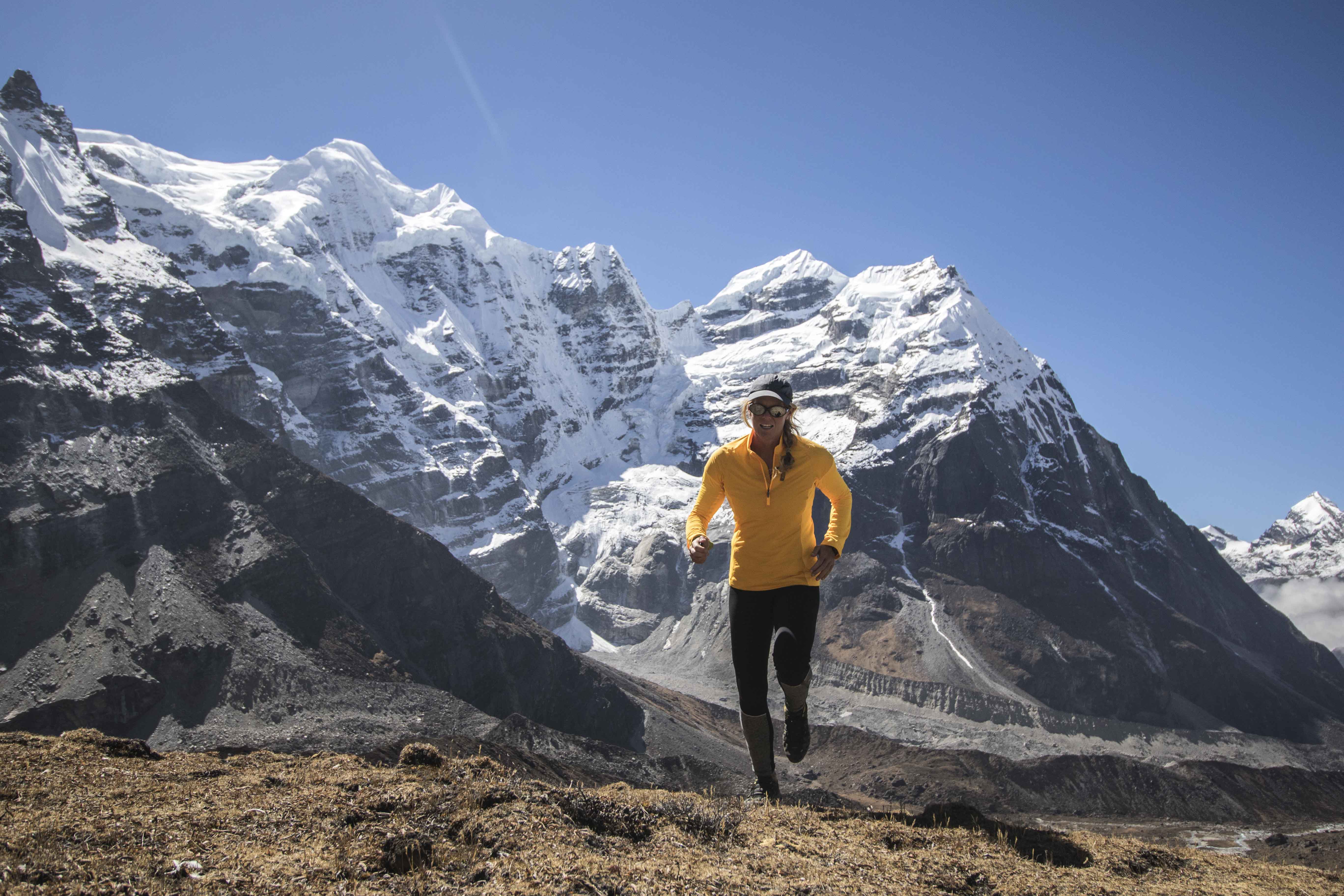
The morning after her wedding, Sunny Stroeer meets me at the South Mesa trailhead at 8 a.m. sharp. As I pull into the parking lot, she’s already rearranging her backpack in the side-pull door of Eddie — her 2004 Astro Van that she lived in for two years before joining her now-husband in a Boulder apartment.
“Good morning,” she yells over.
“You didn’t tell me you were getting married last night.” I jump out of my truck. Sunny walks over and leans down to wrap her iron-hard arms around me. I’d only learned about her marriage late last night after a mutual friend mentioned it.
She shrugs. “Yeah, well, it was the only time we could do it (get married), and today was the only day for our run.”
I knew at least the later half was true — between her traveling schedule as a professional athlete and my juggling of jobs, today was a small overlapping window for us to run Boulder’s Skyline Traverse together, a 16-mile link-up of trails that go up and over the five major peaks flanking Boulder’s western edge: South Boulder Peak, Bear Peak, Green Mountain, Flagstaff Mountain and Mount Sanitas. The plan was to do that, and then turn around and run the more-flat South Mesa trail back to the cars. In total, we were looking at a 30-ish-mile day, which was longer than any run I’d ever attempted.
As Sunny swung her backpack over her shoulder, cinched it tight, fixed her water hose and started her GPS watch, a thought that I’d been avoiding for the past few days popped to the forefront of my mind: I’d actually have to keep up with this 35-year-old German endurance athlete.
I’d first met Sunny only six weeks before, when I’d cold-emailed her with an interview request. In February she’d become the third human (and first woman) to complete Argentina’s 64-mile “360 Route,” which circumnavigates and summits the second-highest of the Seven Summits, the 22,841-foot Aconcagua. I wanted to write about her, to find out why she quit her jet-setting international consulting gig in order to pursue a van-dwelling, no-health-insurance life of adventure.
She was the one, at the end of our interview, to suggest running the Skyline together. Trotting alongside her now, toward the beginning of the trail’s first section that climbs 3,000 feet up South Boulder Peak, I started to connect more of the dots that’d led her to Eddie the Van, her marriage, and breaking trail running and high altitude mountaineering records around the world.

I knew she’d grown up just east of Frankfurt, Germany, and that she’d come to the U.S. for college after a year of studying in Switzerland. She told me she wasn’t at all outdoorsy back then — during her time in Switzerland, she left town limits once. It was the same during the rest of her undergraduate experience at Harvard. Not until leaving Boston did she begin to entertain the idea of adventure, and mostly at the behest of a mentor who (also a race car driver) told her, “Drive fast and take chances.”
The thing is, Sunny’s not particularly fast. Which, she’d told me before but I didn’t believe. Within a few minutes on the trail, she’s breathing hard. “Do you mind if we walk this?”
I exhale relief: I’m also sucking wind, and we shift into a hiking pace.
“I haven’t run since coming back from Aconcagua,” she says. “This is good for me.” Considering it’s been more than two months since she left Argentina, I’m impressed she’s willing to take on a 30-mile run out of the blue, but I quickly learn that’s how Sunny rolls: When there’s no good reason not to, she just does things she knows will be hard.
Like running for 47-and-a-half hours straight around Aconcagua, or training for her first 100-mile race on a 9-mile loop, or trying to set a speed record above 20,000 feet with a respiratory infection (and succeeding).
In any case, ahead of us looms the staircase of rocks stacked along South Boulder Peak’s spine. If you don’t already know, trail running is mostly hiking uphill as fast as your lungs will allow, and then cruising as safely as possible downhill. Sometimes there’s not a lot of actual running. We stomp up the boulders and finally break treeline. Behind us Eldorado Canyon shoots west and open space melts south toward Pikes Peak into the horizon.

Aconcagua was the first “big mountain” Sunny climbed without a guide, and the experience fundamentally shifted the trajectory of her life. It was 2014 and she was still working as many as 80 hours a week as an international strategy consultant. While she summitted the peak without any hiccups, she returned to the U.S. with an unpleasant aftertaste. Seeing so few women on the mountain unsettled her sense of place and purpose — it actually wasn’t so different from the business world, she realized, where she watched women default to men’s decisions all the time. “I just don’t see why that’s necessary,” she’d told me.
While she’s well versed in larger diversity issues that extend beyond the female experience, she says that’s the representation gap she’s felt firsthand the most, and the issue she wants to tackle first. Now as a full-time photographer, mountain guide and public speaker, Sunny’s mission is to be someone people look at and think: “If she can do it, I can too, and maybe even faster.”
There’s a little bit of fire in her, you could say.
Pushing up the final stretch to South Boulder’s summit, exposed on the ridge, I look around and think about the power of visibility — how true it is that I’m much more likely to think about trying something if I see someone who looks like me doing it. I’ve been passed by dozens of men, faceless, on trails before, but I’ll never forget the glacier blue eyes of the young woman who, scooting past me at 5 a.m. with nothing but climbing shoes tied to her hip, was en route to Rocky Mountain alpine terrain. What is possible out there? Maybe that’s not how I wish my inspiration worked, but I know others feel this, too.
The trail connecting South Boulder and Bear Peak is short and sweet. We jog back down the slope together, along the path lined with trees black-burnt from the 2012 fire, and we start up Bear’s backside. Sunny’s ankle is feeling a little wonky from an old injury, so we pick our way through more rocks with care.

From Bear Peak’s summit we can see the tips of the Flatirons down below. It’s where she met Paul, her husband, at the base of the First Flatiron. I laugh: how “Boulder” could one get?
We scan the city below and I point out where I live, underneath that one cluster of green trees. Funny how things look different from up high. When I hold my palm up to the sky, my entire home fits in a space smaller than my thumbnail.
Leading up to 2015, Sunny spent most weekends traveling, jetting off to Ouray for ice climbing or the Caribbean to scuba dive, or the Alps to meet with a then-boyfriend. Eventually she had to confront reality: What was the point of a career that demanded so much time and energy when all she wanted to do was conserve that energy for more time outside? Further: if a promotion at work demanded more time, was that, in fact, a demotion in her adventure life?
So she quit. She drove up to the roof of her parking garage in Houston, Texas, and, with a trusty handsaw, outfitted Eddie the Van with a bed platform. She pared down her belongings — in Eddie, everything needed a use, if not two or three. She learned to value materials differently. Growing up with a doctor and financial advisor as parents and later as a professional herself, if something broke or wore out, like a tent pole or jacket, it was simply replaced.
“Fixing things is actually worth my time now,” she explains as we descend Bear Peak, telling me about the YouTube fix-it videos she’s watched and how her time, in general, is worth a lot more now. She’s happier on the road. She’s more fulfilled. The trail here is soft and gracefully swoops downhill more than a thousand feet. Our legs fly, lungs pumping. Then we start the climb up Green Mountain and shift back to a hike.
I’ve had that experience, too, watching time grow when you escape societal constraints. The way days lengthen without cell phones or how weeks without deadlines expand is eerily magical.
I check in with Sunny about her ankle. Still off, she tells me, but OK for now.

I feel strong moving alongside her, and maybe it’s because she’s got a bum ankle and hasn’t run in the past two months, but maybe it’s because her smile, each time we stand atop a summit, reminds me that we both choose to spend our time out here, simply for the sake of being out here. We’re not running a race or setting a speed record; we’re investigating the boundaries of our human potential, seeing if today we can stake out a little more room.
When Sunny quit her job and moved into Eddie, she set goals for herself. One was to lead a group of women up Aconcagua, which she executed in 2016 and again in 2017. The 2016 expedition led to her first speed record, when, after acclimating during the team’s ascent, she became the fastest woman to move the 8,501 vertical-feet from base camp to summit in 8 hours and 47 minutes.
Similarly, the team expedition in 2017 acclimated her for the 360 Route, which she hadn’t even planned to try until some other mountain plans fell through. With a mere couple weeks to prepare, the fact that, so far, no woman had been successful didn’t deter her. Why not just try?
She assures me again and again 47-and-a-half hours for 64 miles is not ground-breaking. “Someone can go and beat that, easily,” she says. In truth, she doesn’t like to talk about any of her records. She never once mentioned to me her 2017 record-smashing run around Nepal’s 137-mile Annapurna Circuit, when she sliced more than 14 hours off the previous fastest known time. I only found out about it while researching her online. Turns out she decided to push for that speed record, too, on a whim after spending a few weeks guiding clients in the Himalayas and one day thinking, “Well, why not try?”
The records aren’t the point — they’re each just a puzzle piece that adds to the larger picture of female potential. She sees herself getting the ball rolling for other women to continue moving down the line.
But when I connect the biggest similarity between her Annapurna FKT, her completion of Aconcagua’s 360 route, and even today’s Skyline run, I can’t help but smile. In none of those instances was she certain she could finish, let alone be the fastest. But she didn’t let that stop her. In every instance she just decided to try.
Standing next to her on Green Mountain’s summit, I realized I was thinking exactly what she wanted me to think: If she can do it, I can too. Maybe faster, maybe, eventually.

We head down, down, down from Green and after a few minutes I pause. “I don’t think this trail goes to Flagstaff.”
Sunny pulls up a map on her phone. “Nope.” She pivots and starts uphill again. “Just training!” she shouts back at me.
That’s exactly it, the perspective shift she lives by, the one that’s contributed heaps to her success as an ultra-athlete. A downhill trail and an uphill trail are the same compilation of dirt and stones. The way you look at it changes its character, changes how you feel about it.
I smile as I start uphill again, feeling the juicy burn in my quads.
Once we find the right trail, we summit Flagstaff without much fanfare. Sunny reminds me to eat a snack as we sit on a bench adjacent to the summit’s parking lot. “You can’t ever let yourself get hungry,” she says. Keep feeding the mind and the body is how I interpreted that advice.
Jogging behind Sunny on the final stretch up Mount Sanitas it hit me: You really can’t add minutes to your day. That’s what she’d been trying to do, traveling all over the world on weekends as a consultant. But, when you shift your perspective — whether that’s quitting your job or paring down the clutter in your life — you can add value to each minute of your day. And in the end, that’s what we really want in life, right? Not more, just better.
When we get to the base of Sanitas, we sit down at the picnic bench and pull out the stash of water and snacks I’d cached in a tree for us the day before. She props up her foot. “Yeah, I think I’m gonna call it quits,” she says, looking at it.
I shovel more chocolate in my mouth and exaggerate a frown. “Do you mind if I finish?” I’m so curious. I think I can still crank out another nine miles, but it’ll be going into territory unknown.
“Totally,” she says, and adds, “You got this.”
After she calls an Uber, I finish along the Mesa trail alone, shuffling one foot in front of the other, passing trees and boulders I’ve passed a hundred times before on this trail, but this time they seem different. When I reached my truck, I look down at my watch. Almost 30 miles exactly. Something I never thought I could have done a year ago.
Weeks later, I’m sitting with Sunny on a friend’s porch and she asks me to try traversing 150 miles with her through the Grand Canyon. Without missing a beat, I think, “Why not?”
On the Bill: From Nepal to the Andes: Running the Great Ranges, a talk with Sunny Stroeer. 7 p.m. Thursday, June 28, Neptune Mountaineering, 633 S. Broadway, Boulder. neptunemountaineering.com















